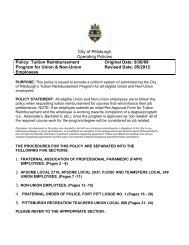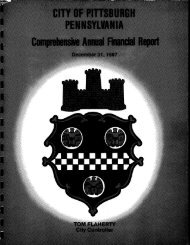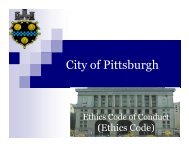east liberty station: realizing the potential - City of Pittsburgh
east liberty station: realizing the potential - City of Pittsburgh
east liberty station: realizing the potential - City of Pittsburgh
You also want an ePaper? Increase the reach of your titles
YUMPU automatically turns print PDFs into web optimized ePapers that Google loves.
96<br />
Conflicting goals <strong>of</strong> all parties involved can<br />
add to <strong>the</strong> cost or time frame necessary to<br />
implement TOD. Ultimately, successful<br />
TOD requires good markets, good <strong>station</strong><br />
areas and excellent coordination between<br />
numerous parties all dedicated to its<br />
success. With all <strong>of</strong> <strong>the</strong>se ingredients, <strong>the</strong><br />
study area is uniquely positioned to<br />
capitalize on TOD opportunities. However,<br />
<strong>the</strong> current infrastructure and urban fabric<br />
remains a hindrance to dense, mixed-use<br />
development in <strong>the</strong> vicinity <strong>of</strong> East Liberty<br />
<strong>station</strong>. Uncertainty as to how <strong>the</strong>se<br />
improvements will be financed deters <strong>the</strong><br />
development community from advancing<br />
projects despite improving market<br />
conditions. A financial strategy to address<br />
<strong>the</strong> site specific and district-wide<br />
impediments to TOD is critical to unlocking<br />
<strong>the</strong> estimated $280 million <strong>of</strong><br />
redevelopment <strong>potential</strong> in <strong>the</strong> elTRID<br />
study area.<br />
TRID Background<br />
elTRID represents <strong>the</strong> planning study<br />
mandated by Pennsylvania’s Transit<br />
Revitalization Investment District (TRID) Act<br />
238 <strong>of</strong> 2004 for municipalities, Counties and<br />
public transportation agencies seeking to<br />
implement a TRID based value capture<br />
strategy. Introduced with active<br />
participation by <strong>the</strong> Delaware Valley<br />
Regional Planning Commission, this<br />
innovative legislation passed by <strong>the</strong><br />
Commonwealth seeks to facilitate TOD,<br />
especially joint development opportunities.<br />
The Act defines <strong>the</strong> processes and<br />
procedures for <strong>the</strong> creation <strong>of</strong> a designated<br />
TRID whose intent is to:<br />
• Coordinate transportation, land use<br />
and private investment by promoting TOD<br />
and joint development.<br />
• Increase ridership on public<br />
transportation systems while generating<br />
additional revenues for current and<br />
expanded services, capital improvements<br />
and related ongoing maintenance.<br />
• Promote multi-municipal,<br />
cooperative approaches to generate new<br />
investment and community revitalization.<br />
• Establish appropriate mechanisms<br />
to capture <strong>the</strong> real property taxation and<br />
o<strong>the</strong>r values added by TOD activities for<br />
reinvestment in <strong>the</strong> transit system and<br />
local communities.<br />
• Encourage greater community<br />
involvement in design, implementation<br />
and investment activities.<br />
• Leverage existing Federal and<br />
State laws and programs.<br />
The creation <strong>of</strong> a TRID itself does not<br />
represent a direct source <strong>of</strong> upfront funding<br />
for TOD, transit improvements or o<strong>the</strong>r<br />
public infrastructure. Though <strong>the</strong> Act directs<br />
<strong>the</strong> PA Department <strong>of</strong> Community and<br />
Economic Development and o<strong>the</strong>r agencies<br />
to commit resources to assist with TRID<br />
implementation, <strong>the</strong> only funds available are<br />
for planning studies. No capital funding is<br />
currently committed directly and exclusively<br />
to TOD projects or o<strong>the</strong>r TRID initiatives.<br />
Developers or local public agencies seeking<br />
financial assistance must apply to o<strong>the</strong>r<br />
broad economic development programs.<br />
As budgetary pressures mount at all levels<br />
<strong>of</strong> government, <strong>the</strong>se funding programs are<br />
increasingly under scrutiny, continually<br />
faced with allocation cuts and thus more<br />
competitive than ever. The lack <strong>of</strong> a<br />
dedicated funding source has hindered <strong>the</strong><br />
implementation <strong>of</strong> TRID’s that have been<br />
studied throughout <strong>the</strong> Commonwealth. The<br />
Act however enables <strong>the</strong> use <strong>of</strong> a districtbased<br />
tax increment financing mechanism to<br />
capture increases in real property taxes<br />
resulting from new assessed values to pay<br />
for necessary improvements detailed in <strong>the</strong><br />
planning study. Although each features key<br />
differences regarding establishment and<br />
implementation, TIF and TRID are<br />
essentially <strong>the</strong> same financing tool based<br />
upon future tax revenues generated by<br />
projects that create new assessed value.<br />
Significant redevelopment projects <strong>of</strong>ten<br />
face funding gaps that result from necessary<br />
public infrastructure. TIF assists <strong>the</strong>se<br />
projects in <strong>the</strong> form <strong>of</strong> developer repayment<br />
<strong>of</strong> a portion <strong>of</strong> eligible costs incurred or by<br />
providing up front financing <strong>of</strong> certain<br />
improvements. Financing districts are<br />
created ei<strong>the</strong>r to facilitate single projects or<br />
various projects within a defined area. In<br />
southwestern PA, TIF is most commonly<br />
applied for specific known projects ra<strong>the</strong>r<br />
than <strong>the</strong> district-wide model used elsewhere<br />
In <strong>the</strong> in <strong>the</strong> country. Both <strong>the</strong> Bakery<br />
Square and Target component <strong>of</strong> Eastside<br />
benefited from TIF.<br />
Due to <strong>the</strong> upfront capital need to fill funding<br />
gaps, TIF typically utilizes incremental tax<br />
revenues generated to finance debt incurred<br />
to construct a project. TIF is nationally<br />
recognized as an instrument <strong>of</strong> economic<br />
development finance, but TRID is not an
















